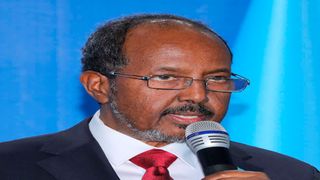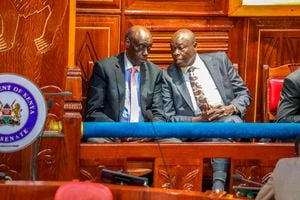
Somalia President Hassan Sheikh Mohamud speaks during his inauguration ceremony in Mogadishu on June 9, 2022.
| AFPOur Columnists
Premium
The anatomy of Hassan Sheikh’s ‘Smart Jihad’
On August 5, President Hassan Sheikh Mohamud launched “Operation Black Lion”, the second phase of his government’s multi-pronged offensive against al-Qaeda-affiliated al-Shabaab militia.
Expected to rid the country of the terrorist group by July next year, the operation – already underway in the eastern regions of Galgmudug – will sweep across the South West state and Jubaland.
Drawing on crucial lessons from the hits and misses in the first phase that began in June 2022, the operation is unfolding as a “Smart Jihad” that expands the “Big tent” approach, deepens networks with local clan militias and elite to build the government’s staying power in liberated areas, counter al-Shabaab’s resurgence and resilience, confront complex clan dynamics and forge new partnerships with Somalia’s neighbouring states ahead of the eventual exit of the African Union Transition Mission in Somalia in 2024.
On September 14, I embarked on a 1,668-kilometre journey to Dusamareb, the enchanted capital of Galmudug state in central Somalia.
Since early August, Mohamud has operated from Dhusamareb, symbolically taking command of the battlefront.
In this pristine land, I witnessed first-hand the patriotic feel of the “Smart Jihad” that he has personally commanded from the historic town.
Onboard Somalia’s “Freedom Airline” to Mogadishu, I mused over the form of power that would set the country free from terrorism, and who will hold that emancipatory power by 2024.
I re-read John Kenneth Galbraith’s The Anatomy of Power (1983) to make sense of the main sources of al-Shabaab’s criminal power: the trinity of money (mafia-style economy), force (violence) and ideology (pseudo-Islam and media propaganda).
This “unholy trinity” has familiar echoes in Joseph Nye’s modern binary of “hard power” (government and the military) and “soft power” of ideology, religion and press.
Smart power
The begotten son of hard power and soft power is “Smart Power” – which essentially involves the strategic engagement of military force and all forms of diplomacy.
This is the post-Shabaab future of power in Somalia.
In May 2022, when Mohamud was elected president, he held a grand vision of Somalia’s happy, united, free and prosperous future with a revised democratic constitution and guided by Somalia Vision 2060, a centenary vision to underpin post-war recovery and development over the next 37 years.
But from nuggets of Somalia’s age-old wisdom, he found and embraced the country’s topmost priority: stability. When a man coming from the warfront with two arrows lodged in his body – one in his eye, the other in his backside – was asked which arrow should be removed first, his answer was apt: “the one in the rear so that I can sit.”
Somalia, too, needs to sit – and al-Shabaab must be removed first.
But removing Africa’s most resilient and destabilising force linked to 2,553 violent events and 6,225 fatalities by 2022 is no mean feat.
Al-Shabaab is a Janus-faced enemy that blends guerrilla tactics and mafia-like terrorism.
It draws its criminal power from $100-300 million revenue extorted from 16 of Somalia’s 18 regions that funds 5,000 to 10,000 fighters and a network of operatives – nearly a third of the Kenya Defence Forces personnel estimated at 29,000 in 2019!
HSM, as President Mohamud is fondly known by his people, has a manifestly complex web in partnerships to defeat the insurgency, guided by three pillars: military, economic and ideology.
On the military front, he made deals with local clan militias, called Ma’awhisley to fight alongside federal soldiers, providing better knowledge on the ground and preventing sympathetic locals from helping the militants.
Recently, Mohamud has widened the partnership to draw in religious leaders, Members of Parliament, senators, business and political elite to support local militias and establish nascent administrative units to hold liberated areas, address grievances, establish justice systems and create sources of livelihoods for young people, thus preventing the return of al-Shabaab.
Ahead of Operation Black Lion, Mohamud reformed the army’s command to ensure effectiveness.
The African Union Mission in Somalia and the country’s international partners are giving support to this architecture.
He has taken bold steps to rallying the nation behind the war. In August, the president hosted federal state leaders in a National Consultative Council, which collectively agreed to energise the preparation of the federal government and member states towards the liberation of Jubaland, South West and the swathes of territory down River Shebelle.
The first phase of the operations, which began in June, covered Middle Shabelle and Hiiraan in HirShabelle state and Galgadud and Mudug in Galmudug state and liberated more than 215 towns from the militia.
But certainly, the biggest task is holding ground and asserting state control in liberated areas.
Al-Shabaab’s recapture of the strategic Ruun-Nirgood and Hilowle Gaab districts from the Somali National Army (SNA) and Ma’awisley militia, who reportedly withdrew without putting up a fight, has been a wake-up call to Mohamud and his administration.
The government has to ensure local clans do not sign peace deals with the militia to ensure their own safety.
Extortions
Second, the war is also economic. A guerrilla is like fish in water. The swamps of al-Shabaab’s revenue from taxes, tolls and extortions must be drained.
Third, the war is ideological too. This entails rallying religious leaders and scholars behind it.
However, the missing link is Galbraith’s fourth pillar of power: a robust press or publicity.
Al-Shabaab has proved very adept at propaganda war. It runs 17,000 social media accounts and posts more than 6,000 items every day or 180,000 posts per month. In military terms, this propaganda blitz amounts to a scorched-earth policy!
President Mohamud travelled to Dhusamareb – the capital of Galmudug – on August 5, where he unveiled Operation Black Lion, setting July 2024 as the final date to rid the country of al-Shabaab.
The offensive has started in the eastern part of Galgadud and the west of Hiiraan, including River Shabelle, as the government prepares to move further to the South West and Jubaland states, two important but tough battlefronts.
Clan-based power-sharing disputes and supremacy tussles in Jubaland can potentially undermine the military operation.
Here, the federal government is already facing headwinds of clan supremacy wars after attempts to recruit Marehan militias in Gedo region.
The government of President Ahmed Mohamed Islam “Madobe” in Kismayu is wary that this might challenge the power of his Ogaden clan, now in power. However, Somalia must be more important than all its clans.
Prof Kagwanja is Chief Executive at the Africa Institute and Adjunct Scholar at the University of Nairobi and the National Defence University-Kenya.





